Good Old-Fashioned Pickled Dilly Beans
This post may contain affiliate links, which means that I may receive a commission if you make a purchase using these links. As an Amazon Associate I earn from qualifying purchases.
Dilly beans are pickled green beans flavored with dill, garlic, and spicy pepper flakes. Learn how to preserve string beans in a water bath canner with this easy recipe.
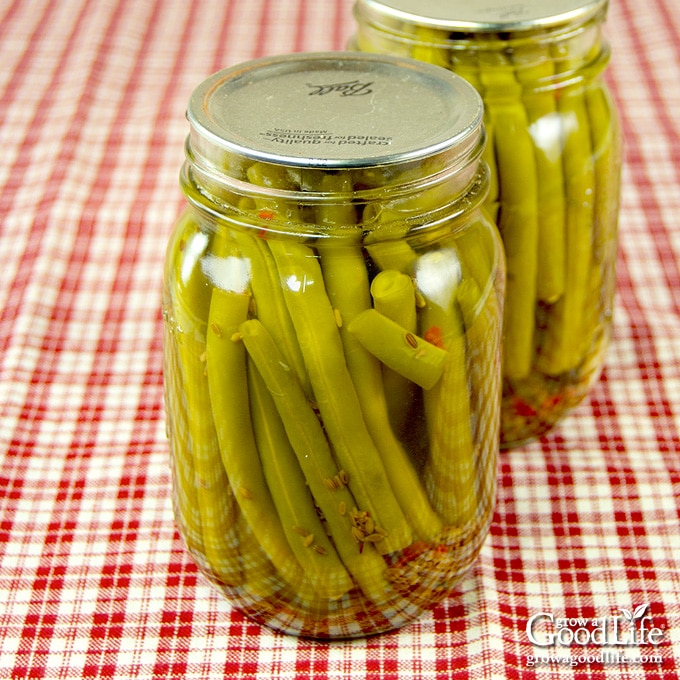
I remember the first time I tried dilly beans. It was at a cookout with friends who were astonished that I had never had them. At their urging, I pulled one of the beans out of the jar with a fork and nibbled on the end to taste it.
It was so good!
I found myself drawn to the jar time and again throughout the day and enjoying the crunchy, vinegary, and intensely flavored dilly beans.
Dilly beans are one of the easiest canning recipes. Because you are pickling the beans, all you need is a water bath canner to preserve the jars.
Serve dilly beans as a side dish as you would pickles, layer them into sandwiches, or include on a charcuterie board or antipasto platters. Of course, whenever you have a craving, go ahead and snack on dilly beans right out of the jar.
Tips for Making Dilly Beans
Dilly beans are zesty pickled string beans flavored with dill, garlic, and spicy pepper flakes. Because we are using vinegar to adjust the acidity, pickled beans can be preserved into shelf-stable jars using a boiling water bath canner. Here are tips for pickling green beans:
Use fresh beans
Green beans, string beans, snap beans, and wax beans are all terms used to describe young pods that are harvested from bush or pole beans. They come in different colors, including green, purple, and yellow. All can be used to make dilly beans.
Fresh string beans will stay crispy when pickled. Skip the limp beans at the supermarket and use freshly harvested beans from your garden, a friend’s garden, or farmers market.
Select the small to medium sized string beans for making crispy dilly beans that snap when you bite into them. Avoid the large, seedy pods because they tend to be tough when pickled. You’ll need about 2 pounds of string beans to fill 4 pint sized canning jars.
Use canning salt
Table salt contains iodine and anti-caking agents that can darken food and make the jars cloudy. Pickling salt, also known as canning salt, is just pure granulated salt (sodium chloride) with no additives.
Type of vinegar for pickling
Use commercial vinegar with at least 5% acidity for pickling. The most common types used for canning are apple cider and white vinegar.
- Apple cider vinegar is made from fermented apples and adds a slightly sweet apple flavor to pickled foods, but it will slightly darken your dilly beans.
- White vinegar is clear vinegar made by distilling corn and rye. The flavor is sharper than apple cider vinegar. Choose an organic brand of white vinegar to avoid genetically modified corn.
Cut the beans to fit the jar
Trim the string beans to fit the jars and remain submerged in the pickling solution. The trimmings can be added to salads, or frozen and used to make homemade stock.
Don’t have a water bath canner?
If you don’t want to pull out a canner, you can use a large pot to process the jars of pickled green beans. I use an 8-quart tall pot with an 8-inch canning rack that holds 4 pint-sized canning jars.
Your saucepan needs to be high enough to cover the tops of the jars by a few inches of water, plus two inches of space to prevent boiling water from splashing out of the pot. Place a rack in the bottom to elevate the jars up away from direct heat, and allow the water to circulate around the jars as they are processed.
How to Can Pickled Dilly Beans
Before you begin, you may find it helpful to review this article on water bath canning at the National Center for Home Food Preservation.
This recipe for dilly beans is from the So Easy to Preserve and the Ball Blue Book Guide to Preserving books. The full and printable recipe can be found at the bottom of this article, but these are the steps for making and canning pickled beans.
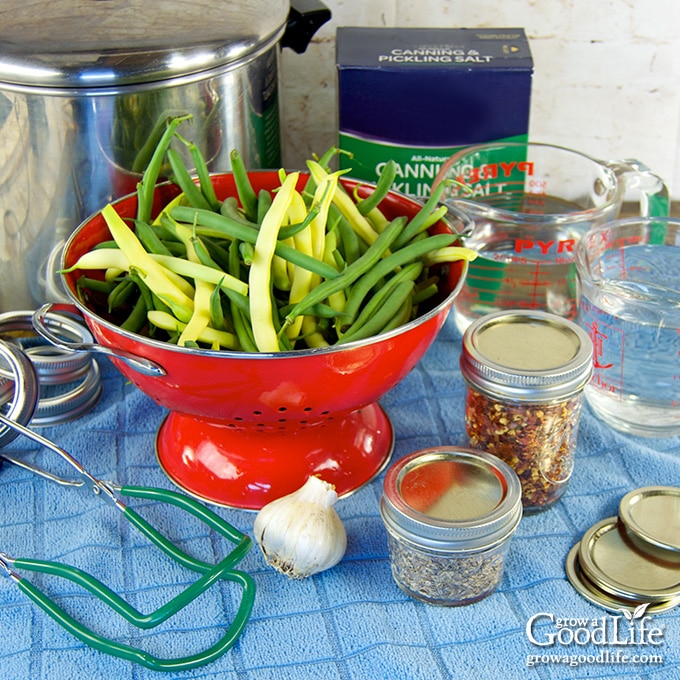
Step 1: Prepare the Canning Equipment
Gather your kitchen and canning equipment, prepare the jars, set up the canner, and organize your work area.
You’ll need:
- Water bath canner or a large pot (8 quart tall) with a rack
- 4 pint sized canning jars
- Lids and bands (new lids for each jar, bands can be reused)
- Canning tools: jar lifter, canning ladle, funnel, and bubble popper
- Plus basic kitchen supplies such as kitchen towels, a large bowl, medium pot, knife, and cutting board.
Wash your jars, lids, bands, and canning tools in warm, soapy water and rinse well. Set the lids, bands, and tools aside to air-dry until you are ready to use them.
Place the jar rack into the canner, set the jars upright on the rack, and add water to cover the jars. Bring the canner to a simmer (180˚F) for 10 minutes, and keep the jars hot until you are ready to fill them. Jars must be warm before filling to prevent a fluctuation in temperature that may cause the jars to break.
Follow the manufacturer’s directions for preparing the lids. Pre-heating lids is no longer necessary before using, but it is still safe to simmer (180°F) the lids if you want to. Just add them to the canner when you heat your jars.

Step 2: Prepare the string beans
Wash the beans under cold running water. Trim off the ends, pull off the strings, and cut the beans to 4-inches to fit the jars.
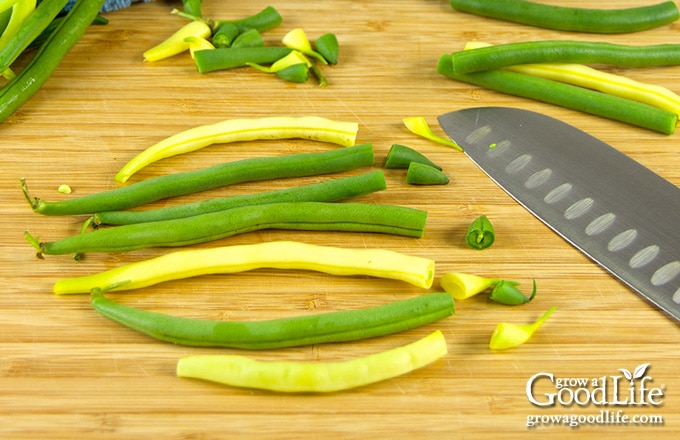
Step 3: Make the pickling brine
In a medium pot, combine the salt, vinegar, and water. Bring to a boil, and then reduce the heat and simmer (180˚F) for 10 minutes. Keep the brine warm.

Step 4: Pack your jars
Spread a kitchen towel on the counter. Use the jar lifter to remove a hot jar from the canner, drain, and place on the towel. Keep the remaining jars in the canner, so they stay warm.
Add 1/4 teaspoon red pepper flakes, 1 clove of garlic, and 2 teaspoons dried dill seeds or 1 head of dill. Pack the string beans lengthwise into the jars. It may help to turn the jar on its side, and stack the beans inside. Try to pack the beans as tightly as you can.
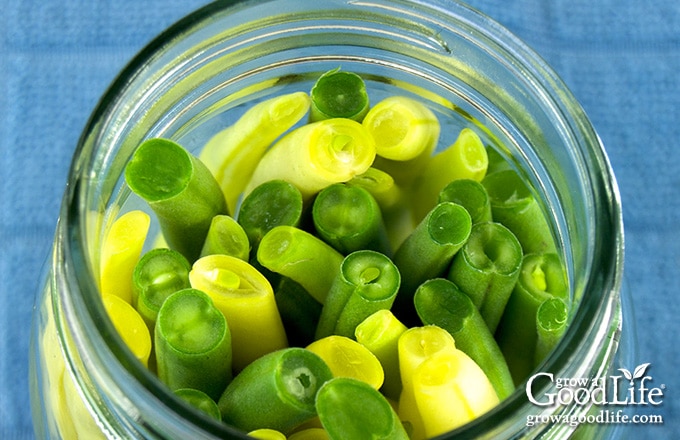
Place the canning funnel on the jar, and ladle hot brine over the beans, leaving 1/2 inch of headspace.
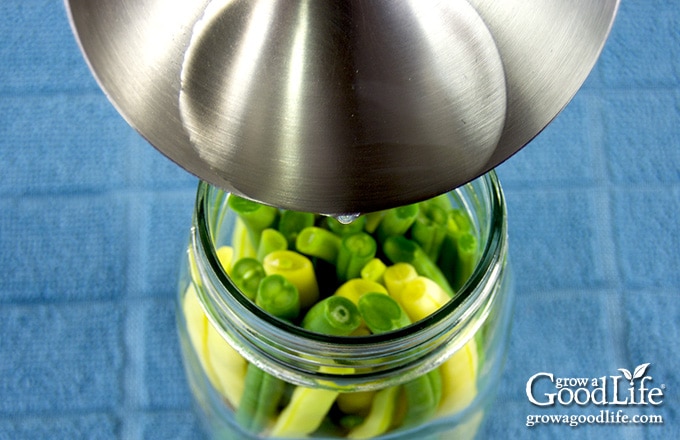
Run the bubble popper through the jar to release any trapped air bubbles. You can also tilt the jar back and forth to let air escape. Add more brine to adjust the headspace again if needed. You want to be sure all the beans are submerged completely in the brine.
Wipe the rim with a damp towel to remove any residue. Center a lid on the jar, place the band over the lid, and screw it on until fingertip tight. Place the jar back into the canner, and repeat with the rest of the jars. Depending on the size of your beans and how tightly you packed them, you may not use all the brine.
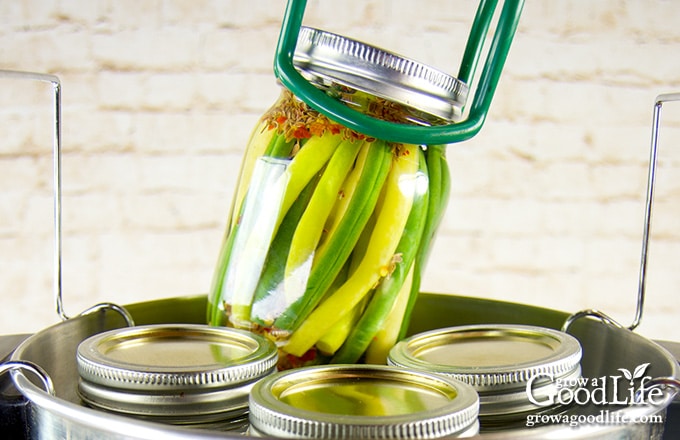
Step 5: Process your jars
Once all the jars are in the pot, adjust the water level so it is covering the jars by several inches. Bring the pot to a boil, and process the jars for the times indicated in the recipe below.
Let the canner cool, remove the jars, and let them cool completely. Test the seals, label and date the jars, and store in a cool, dark location for 12 to 18 months. Allow 2 to 4 weeks before tasting for the dilly beans to develop their flavor. Use within 12 to 18 months.
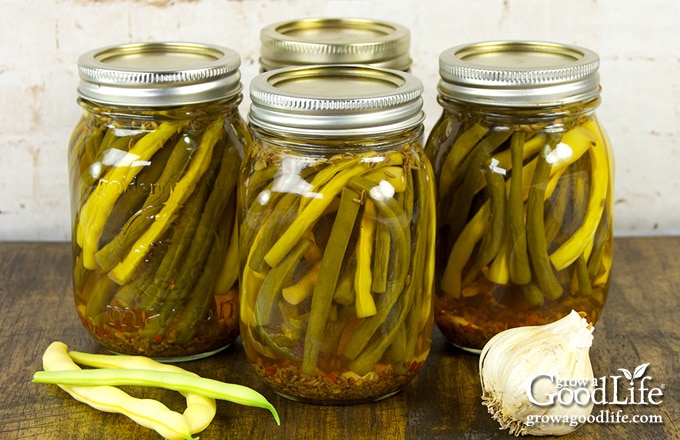
Old-Fashioned Pickled Dilly Beans
Ingredients
- 2 pounds fresh string beans
- 1/4 cup canning salt
- 2 1/2 cups white vinegar or apple cider vinegar
- 2 1/2 cups water
- 4 cloves garlic divided
- 8 teaspoons dried dill seeds or 4 heads dill, divided
- 1 teaspoon red pepper flakes divided
Instructions
- Wash your jars, lids, screw bands, and canning tools in hot soapy water. Rinse thoroughly to remove all suds. Set aside to air dry on a clean kitchen towel.
- Place the jar rack into water bath canner, place jars in the canner, and add water to cover. Bring the canner to a simmer (180˚F) for 10 minutes, and keep the jars hot until you are ready to fill them.
- Rinse the string beans and cut into 4-inch pieces to fit in the jar.
- Combine the salt, vinegar, and water in a large pot. Bring to a boil, reduce the heat, and simmer (180˚F) for 10 minutes.
- Spread a kitchen towel on the counter. Use your jar lifter to remove a warm jar from the canner, drain, and place on the towel. Keep the remaining jars in the canner, so they stay hot.
- Add 1 clove of garlic, 1/4 teaspoon red pepper flakes, and 2 teaspoons of dried dill seeds or 1 head of dill to the bottom of the jar.
- Pack the string beans lengthwise into the jars. Try to pack the beans tightly. Pour the hot pickling liquid over the string beans, leaving 1/2 inch of headspace.
- Run the bubble popper through the jar to release any trapped air bubbles. You can also tilt the jar back and forth to let air escape. Add more brine to adjust the headspace again if needed to maintain a 1/2 inch. You want to be sure all the beans are submerged beneath the brine.
- Place the jar back into your canner, and repeat with the rest of the jars.
- Once the jars are in the canner, adjust the water level so it is 2-inches above the top of the jar.
- Cover the canner, and bring it to a boil over high heat. Once the water boils vigorously, continue boiling for 10 minutes at altitudes of less than 6,000 feet. Adjust processing time for your altitude if necessary (See Note).
- When processing time is complete, turn off heat, and let the canner cool down and settle for about 5 minutes.
- Spread a dry kitchen towel on the counter. Remove the cover by tilting lid away from you so that steam does not burn your face.
- Use the jar lifter to remove the jars from canner and place on the towel. Keep the jars upright, and don't tighten bands or check the seals yet. Let the jars sit undisturbed for 12 to 24-hours to cool.
- After 12 to 24-hours, check to be sure jar lids have sealed by pushing on the center of the lid. The lid should not pop up. If the lid flexes up and down, it did not seal. Refrigerate jar and use up within 2 weeks.
- Remove the screw on bands and wash the jars. Label, date, and store your jars in a cool, dark place for 12 to 18 months. Allow 2 to 4 weeks for the dilly beans to develop their flavor. Once the jar is open, store in the refrigerator for up to 2 weeks. Recipe makes about 4 pints.
Notes
Nutrition
You May Also Like
- Granny’s Bread and Butter Pickles
- Dill Pickle Spears Canning Recipe
- Pressure Canning Green Beans
- How to Freeze String Beans
40+ Meals in a Jar Pressure Canning Recipes
In this eBook, you will find 50 pressure canning recipes, including 44 meals, along with homemade stocks and bone broths. Recipes include soups, stews, chilis, beans, beef, pork, and poultry. Explore the world of preserving delicious home-cooked meals for all seasons.

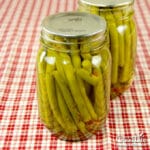

Do you recommend the apple cider vinegar or white vinegar which works the best? Thank you
Kristen, I personally prefer the milder flavor of apple cider vinegar, but the choice depends on your taste preferences. Both apple cider vinegar and white vinegar work well for this recipe.
Hi – I’m excited to try this but I have a few questions – do you know if I can use Redmond real salt instead of canning salt? And can you sub in other vegetables for the beans or will it not be the proper acidity? I was wanting to try doing zucchini as well. Thanks!
Hello Erica! Yes you can use Redmond’s fine salt instead of canning salt in your pickled dilly beans. However, when it comes to substituting other vegetables like zucchini, it’s important to stick to tested recipes to ensure proper acidity and safety. Changes to vegetable types can affect the final pH and potentially the safety of the canned product. I recommend following tested recipes for pickled vegetables from trusted sources like Ball or the National Center for Home Food Preservation (nchfp.uga.edu/how/veg_pick.html) to ensure the best results. Enjoy your pickling adventure!
Hi! I love this recipe! I’d like to make it in quarts, how much of the dill seed/pepper flakes/garlic do I use per jar? And are the processing times the same? I really appreciate it! My husband can’t get enough of these!
Hey Alex! I’m thrilled to hear that you love the recipe! This recipe is also in the Ball Blue Book and is safe for canning in both pints and quart sized jars. Instead of 4 pints, you can use 2 quarts. To make it in quarts, you can double the flavorings for each jar. Add 1/2 teaspoon of red pepper flakes, 2 cloves of garlic, and 4 teaspoons of dried dill seeds (or 2 heads of dill) to the bottom of each quart jar. The processing time remains the same for both pints and quarts. Happy canning, and enjoy those delicious pickles!
Thank you so much for this information!!
You mentioned in step 12 to take the lid off the water bath before letting it cook down and rest for five minutes, but then in the very next step, step 13, said to take off the lid again tilting it away so the steam doesn’t burn you.
Do we take the lid off before or after letting the bath canner cool down and rest for the five minutes??
Thank you and I can’t wait to try this tomorrow!
Leah, Apologies for any confusion. Let me clarify the process for you. After the processing time is complete, turn off the heat and allow the canner to cool down and settle for about 5 minutes with the lid on. Then, once the 5-minute resting period is over, carefully remove the canner’s cover by tilting it away from you to avoid steam burns. I hope this clears things up. Happy canning, and I hope your batch turns out fantastic!
Why remove the rings? Is it necessary?
Angela, It’s a good idea to remove the rings and wash the jars with warm soapy water to remove any residue that might encourage mold growth during storage. I also highly recommend leaving the rings off when storing the jars because they can hide potential issues. If a jar’s seal fails, the ring might still hold the lid in place, giving a false impression of safety. The jars should remain safely sealed even without the rings.
Not sure what I did, but only had brine for 3 16 oz jars.
Julie, With canning, the jar yields are only an estimate. There are always some slight variations depending on the size of the pieces. Did you measure and include the vinegar and water in the brine? Five cups should be plenty of liquid to fill 4-pint jars full of beans. Here are a few reasons why you may have been short: Were your jars filled tightly with beans? If there were fewer beans, you would need more liquid to fill the jars. Did you simmer or boil the brine? If you boiled it, some might have evaporated. You could make up a little extra brine for next time.
The seals did not pop! What happens now???! Thanks
Deborah, Did your jars seal? The newer lids may not make a popping sound. If your lids do not seal, refrigerate the jars and consume within 3 months.
Please show me the bubble popper. I’m just curious. I use a skewer
Pat, Using a skewer is a great choice for releasing air bubbles in your jars. You want to avoid anything metal because it can etch the glass, weakening the jar. You can find bubble poppers included in the canning tool set that I linked to above.
I love this recipe SO much that I want to pack them in quart jars. How long would they need to go in the water bath?
Holly, I checked the Ball Blue Book Guide to Preserving and the processing time is the same for both pints and quarts for this recipe. Enjoy!
I followed your recipe and just read on Facebook to always pressure can strings beans to never just do water bath?
Tricia, Yes, always pressure can plain string beans. However, pickling makes these beans safe for canning. Vinegar and salt changes the acidity and makes it safe for water path canning. You can learn more about pickled vegetables at the Clemson extension website: Pickle Basics Factsheet
Hi there, I made the recipe and all my jars have sealed. It has been 24hrs and I can see the beans are now floating up out of the brine. Are they still safe to store and consume?
Thanks!
Madison, Floating happens quite often in pickled recipes. Air in the vegetables can cause the pickles to float even after processing. But, they often eventually settle as the pickling brine infuses into the beans. Your dilly beans are ok as long as you followed the recipe and the seal is tight. Exposed beans can become tough and less tasty but are safe to consume.
Thank you for this!